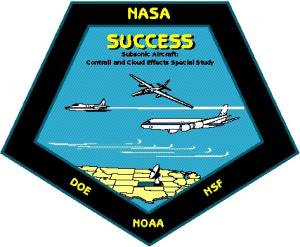SUbsonic aircraft: Contrail & Clouds Effects Special Study (SUCCESS)
SUCCESS is a NASA field program using scientifically instrumented aircraft and ground based measurements to investigate the effects of subsonic aircraft on contrails, cirrus clouds and atmospheric chemistry. The experiment is cosponsored by NASA's Subsonic Assessment Program and the Radiation Sciences Program which are part of the overall Aeronautics and Mission to Planet Earth Programs, respectively. SUCCESS has well over a hundred direct participants from several NASA Centers, other agencies, universities and private research companies.
SUCCESS is coordinating with the Department of Energy's Atmospheric Radiation Measurements Program (ARM) which operates the Clouds and Radiation Testbed (CART) site located in Northern Oklahoma, and Southern Kansas. In addition to the extensive ground based measurements at the CART site, ARM will also make airborne measurements with scientifically instrumented Remotely Piloted Aircraft (RPA's).
SUCCESS has several objectives. We plan to better determine the radiative properties of cirrus clouds and of contrails so that satellite observations can better determine their impact on Earth's radiation budget. We hope to determine how cirrus clouds form, whether the exhaust from subsonic aircraft presently affects the formation of cirrus clouds, and if the exhaust does affect the clouds whether the changes induced are of climatological significance. We seek to pave the way for future studies by developing and testing several new instruments. We also plan to better determine the characteristics of gaseous and particulate exhaust products from subsonic aircraft and their evolution in the region near the aircraft.
Several aircraft will be used during SUCCESS: a medium-altitude DC-8 and a high-altitude ER-2, both based at NASA Ames Research Center, Moffett Field, California and a T-39 aircraft based at NASA Wallops Flight Facility, Wallops Island, Virginia.
In order to achieve our experimental objectives we plan to use the DC-8 aircraft as an in situ sampling platform. It will carry a wide variety of gaseous, particulate, radiative, and meteorological instruments. We will also use a T-39 aircraft primarily to sample the exhaust from other aircraft. It will carry a suite of instruments to measure particles and gases. We will employ an ER-2 aircraft as a remote sensing platform. The ER-2 will act as a surrogate satellite so that remote sensing observations can be related to the in situ parameters measured by the DC-8 and T-39.
The 5 week SUCCESS field mission deployment is scheduled to begin on Monday 8 April 1996, and will continue through Friday 10 May 1996. During the SUCCESS field deployment, all three NASA aircraft will be based in Salina, Kansas on the Salina campus of Kansas State University. A series of flights, averaging one every other day during this period, will be made mainly near the DOE CART site. Additional flights will be made over the Rocky Mountains, to investigate wave clouds. Flights will also be made over the Gulf of Mexico to utilize an oceanic background for remote sensing measurements.





